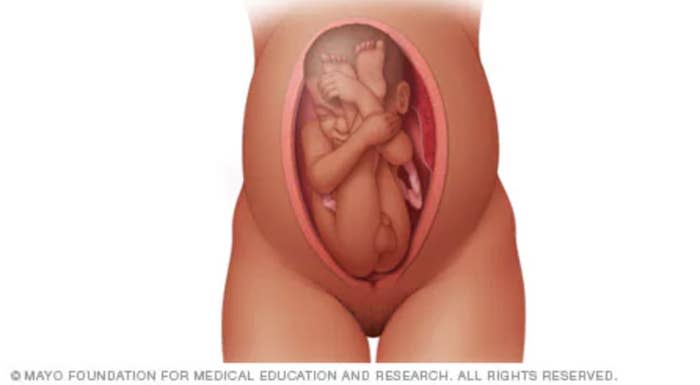This TikTok Of A Woman's "Frank Breech Baby" Went Viral, So I Talked To A Doctor About Why Some Babies Are Born This Way
On Friday the 13th of August, 2021, Kaiya Edwards was born with her legs around her head. That was her go-to resting position for an entire week after her birth. Her mom, Katie Edwards, was so amused by Kaiya's bizarre pose that she uploaded a video of her to TikTok. The video now has almost 30 million views:
@katiekateyo Kaiya arrived 8/13/21 at 8lbs 13oz! She was relaxed in the video.😂 Her legs have straightened out since! #Newborn #Baby #BreechBaby #Breech #BabyGirl
♬ original sound - Katie Edwards
Katie captioned the video, "This is what a Frank breech baby looks like LOL this is why I had a c-section she was in my belly like this." I had never heard of a frank breech baby before, so I decided to reach out to Katie to hear the whole story behind her pretzel-shaped infant.

Halfway through her pregnancy, Katie had an ultrasound that showed her baby in the frank breech position. This is when the baby's bottom is facing the birth canal and their legs are sticking straight up in front their body, with their feet by their head. The doctors told Katie that they'd look again at 37 weeks to see if the baby had turned around. Unfortunately, when they checked again, her position had not changed. "Kaiya was sucking on her toes in the 37-week ultrasound," Katie told BuzzFeed.

"She also was a really big baby," Katie said. "Due to her large size, it was unlikely for her to turn into the right position. So they scheduled me for a C-section at 39 weeks on Friday the 13th of August." The procedure was successful, and Kaiya came out healthy, but she maintained the same position she had in utero.
@katiekateyo Some pictures of Kaiya right after she was born #FrankBreech #BreechBaby #Breech #Newborn #NewbornBaby #BabyGirl #Kaiya #BabyLove #CuteBaby #Adorable
♬ ily (i love you baby) - Surf Mesa
"The nurses were laughing as they cleaned her up because she was in that position on the table," Katie said. "A lot of people [on TikTok] asked if she was stuck like that. She actually would do it when she was relaxed for about a week. After that first week, her legs were normal even when she was relaxed."
To get deeper into the science of the frank breech position and how it occurs, I reached out to OB-GYN Dr. Nicole Rankins, host of The All About Pregnancy & Birth podcast. "Babies move around all the time during pregnancy, so it's not that the baby gets into a breech presentation and automatically stays that way for the duration of the pregnancy," Rankins told BuzzFeed. "They can flip in and out of breech presentation."
She continued, "Most of the time, we don't know why a baby settles into a breech position. Sometimes it can be due to the shape of the uterus — for example, if there is a fibroid that distorts the shape of the uterus and prevents the baby from turning into a head-down position. Also, twins and having low amniotic fluid are associated with breech presentation." Rankins added that breech presentation at birth occurs in about 3% of full-term pregnancies. Of these 3%, frank breech is the most common position.
"Most of the time, we don't know why a baby settles into a breech position. Sometimes it can be due to the shape of the uterus — for example, if there is a fibroid that distorts the shape of the uterus and prevents the baby from turning into a head-down position. Also, twins and having low amniotic fluid are associated with breech presentation," Rankins said. She added that breech presentation at birth occurs in about 3% of full-term pregnancies. Of these 3%, frank breech is the most common position.


